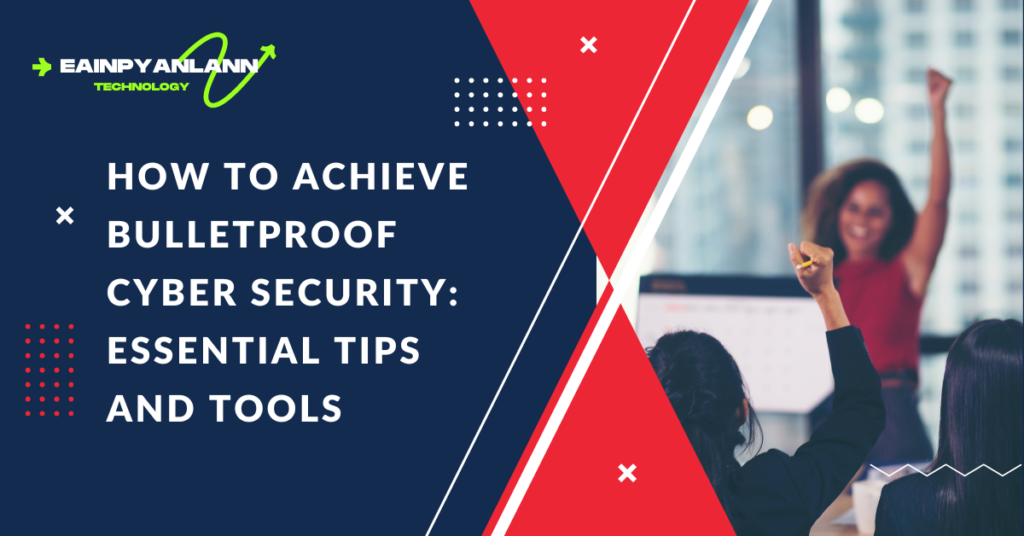In an age where cyber threats are becoming increasingly sophisticated, achieving bulletproof cyber security is crucial for safeguarding your organization’s digital assets. Bulletproof cyber security goes beyond traditional measures, employing advanced techniques and tools to provide maximum protection against evolving threats. This guide offers essential tips and tools to help you achieve bulletproof cyber security.

1. Understand the Threat Landscape
1.1. Identify Common Threats
Understanding the threat landscape is the first step in achieving bulletproof cyber security. Common threats include:
- Malware: Malicious software such as viruses, worms, and ransomware.
- Phishing: Fraudulent attempts to obtain sensitive information by disguising as a trustworthy entity.
- Insider Threats: Security risks posed by employees or trusted individuals.
1.2. Analyze Emerging Threats
Stay informed about emerging threats and attack vectors. Regularly review threat intelligence reports and security advisories to understand the latest tactics used by cybercriminals.
2. Implement Advanced Threat Detection
2.1. Use Behavioral Analysis
Behavioral analysis involves monitoring user and network behavior to detect anomalies that may indicate a potential threat. Tools that utilize behavioral analysis include:
- User and Entity Behavior Analytics (UEBA): Identifies deviations from normal behavior patterns.
- Network Traffic Analysis (NTA): Monitors network traffic for unusual patterns or activities.
2.2. Leverage Artificial Intelligence (AI) and Machine Learning (ML)
AI and ML can enhance threat detection by:
- Analyzing Large Data Volumes: AI and ML algorithms can process and analyze vast amounts of data to identify threats quickly.
- Predicting Threats: These technologies can predict potential threats based on historical data and patterns.
3. Employ Multi-Layered Defense Strategies
3.1. Implement Next-Generation Firewalls
Next-generation firewalls (NGFWs) offer advanced features beyond traditional firewalls, such as:
- Deep Packet Inspection (DPI): Analyzes the content of network packets to detect and block threats.
- Application Control: Monitors and controls applications running on the network.
3.2. Deploy Advanced Endpoint Protection
Advanced endpoint protection solutions provide:
- Real-Time Threat Detection: Continuous monitoring for suspicious activities on endpoints.
- Behavioral Protection: Identifies and blocks malicious behaviors on endpoints.
4. Strengthen Authentication and Access Control
4.1. Use Multi-Factor Authentication (MFA)
Multi-factor authentication (MFA) adds an extra layer of security by requiring multiple forms of verification, such as:
- Something You Know: A password or PIN.
- Something You Have: A mobile device or hardware token.
- Something You Are: Biometric factors like fingerprints or facial recognition.
4.2. Implement Least Privilege Access
Least privilege access ensures that users have only the minimum level of access necessary for their roles. This can be achieved by:
- Role-Based Access Control (RBAC): Assigning permissions based on user roles.
- Regular Access Reviews: Periodically reviewing and adjusting access permissions.
5. Enhance Data Protection
5.1. Encrypt Sensitive Data
Encryption protects data by converting it into an unreadable format for unauthorized users. Key encryption practices include:
- Data Encryption at Rest: Encrypting data stored on devices and servers.
- Data Encryption in Transit: Encrypting data transmitted over networks.
5.2. Implement Data Loss Prevention (DLP)
Data loss prevention (DLP) solutions monitor and protect sensitive data from unauthorized access, use, or disclosure. DLP tools can:
- Detect Data Breaches: Identify potential breaches or leaks of sensitive information.
- Enforce Data Policies: Implement policies to prevent unauthorized data access or transfer.
6. Develop a Robust Incident Response Plan
6.1. Create an Incident Response Team
Assemble a dedicated incident response team (IRT) responsible for managing and responding to security incidents. The team should include:
- Incident Response Manager: Oversees the response process.
- Technical Experts: Provides expertise in forensic analysis and remediation.
- Communication Specialists: Manages internal and external communications during an incident.
6.2. Develop and Test Incident Response Procedures
Incident response procedures should outline steps for detecting, containing, and recovering from incidents. Key components include:
- Incident Detection: Methods for identifying and reporting potential incidents.
- Containment and Eradication: Procedures for isolating and removing threats.
- Recovery and Lessons Learned: Steps for restoring normal operations and analyzing the incident to prevent future occurrences.
7. Regularly Update and Patch Systems
7.1. Implement a Patch Management Process
Patch management involves regularly updating software and systems to fix vulnerabilities. Key practices include:
- Automated Patching: Using tools to automate the patching process.
- Regular Patch Reviews: Reviewing and applying patches on a regular basis.
7.2. Monitor for Vulnerabilities
Regularly scan systems and applications for vulnerabilities using:
- Vulnerability Scanners: Tools that identify known vulnerabilities in software and systems.
- Threat Intelligence Feeds: Information on newly discovered vulnerabilities and exploits.
8. Foster a Culture of Cyber Security Awareness
8.1. Conduct Regular Training and Awareness Programs
Cyber security training helps employees recognize and respond to threats. Training programs should cover:
- Phishing Awareness: Identifying and avoiding phishing scams.
- Safe Internet Practices: Following best practices for internet usage and data protection.
8.2. Simulate Cyber Attacks
Cyber attack simulations test employee preparedness and response. Conduct simulations such as:
- Phishing Simulations: Test employees’ ability to recognize phishing emails.
- Tabletop Exercises: Simulate cyber incidents to practice response procedures.
9. Utilize Comprehensive Security Solutions
9.1. Invest in Security Information and Event Management (SIEM)
SIEM solutions provide real-time analysis and correlation of security events. Key benefits include:
- Centralized Monitoring: Aggregates and analyzes security data from multiple sources.
- Automated Alerts: Generates alerts based on predefined criteria and threat indicators.
9.2. Adopt a Zero Trust Architecture
Zero Trust Architecture (ZTA) is a security model that assumes no implicit trust within the network. Key components include:
- Verify Every Access Request: Continuously authenticate and authorize users and devices.
- Segment Networks: Implement micro-segmentation to limit lateral movement within the network.
Conclusion
Achieving bulletproof cyber security requires a multifaceted approach that integrates advanced technologies, proactive measures, and continuous improvement. By understanding the threat landscape, employing advanced detection methods, implementing multi-layered defenses, and fostering a culture of security awareness, organizations can enhance their resilience against sophisticated threats. Utilizing comprehensive tools and strategies ensures robust protection for your digital assets, enabling you to navigate the evolving cyber threat landscape with confidence.



Thanks
Thanks.